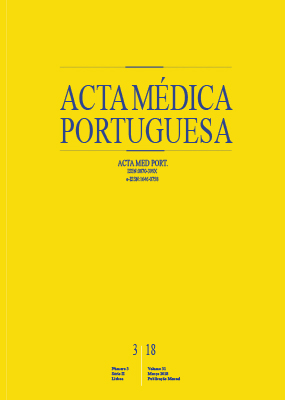Prevalence of Abdominal Obesity and Excess Weight among Portuguese Children and Why Abdominal Obesity Should Be Included in Clinical Practice
DOI:
https://doi.org/10.20344/amp.9000Keywords:
Adiposity, Body Mass Index, Child, Obesity, Abdominal, Pediatric Obesity, PortugalAbstract
Introduction: Central adiposity in children has increased to a higher degree than general adiposity however it is not a routine measurement in clinical practice. We aimed to estimate the prevalence of overweight, obesity, and abdominal fat distribution and observe the prevalence of abdominal obesity among non-obese 6-10-year-old children.
Material and Methods: Weight, height, and waist circumference were measured in a sample of 793 children (408 girls). International Obesity Task Force cut-offs were used to define overweight and obesity. Abdominal obesity was defined as waist-to-height ratio ≥ 0.50. Chi-square tests were used to observe the prevalence of the obesity indicators among boys and girls, and the relation between International Obesity Task Force cut-offs and abdominal obesity.
Results: The prevalence of overweight, including obesity among children was 21.9% (18.9 – 25.0), 6.1% (4.2 – 8.0) were obese and 21.9% (18.6 – 25.0) had a waist-to-height ratio ≥ 0.50. Girls had significantly higher prevalence of overweight, including obesity compared to boys (χ2 = 4.59, p = 0.03), but no differences were found for abdominal obesity according to children’s gender (χ2 = 3.32, p = 0.07). A proportion of normal (8.2%; 5.9 – 10.6) and overweight children (59.5%; 50.9 – 69.0) were abdominally obese.
Discussion: The prevalence of general and abdominal obesity in children living in central Portugal is of concern. Many children with abdominal obesity would not be considered obese with the International Obesity Task Force cut-off points.
Conclusion: A high proportion of abdominal obesity was observed in children with normal weight or overweight, suggesting that waist-to-height ratio should be included in routine clinical practice and might be particularly useful to assess the health status of the child.
Downloads
Downloads
Published
How to Cite
Issue
Section
License
All the articles published in the AMP are open access and comply with the requirements of funding agencies or academic institutions. The AMP is governed by the terms of the Creative Commons ‘Attribution – Non-Commercial Use - (CC-BY-NC)’ license, regarding the use by third parties.
It is the author’s responsibility to obtain approval for the reproduction of figures, tables, etc. from other publications.
Upon acceptance of an article for publication, the authors will be asked to complete the ICMJE “Copyright Liability and Copyright Sharing Statement “(http://www.actamedicaportuguesa.com/info/AMP-NormasPublicacao.pdf) and the “Declaration of Potential Conflicts of Interest” (http:// www.icmje.org/conflicts-of-interest). An e-mail will be sent to the corresponding author to acknowledge receipt of the manuscript.
After publication, the authors are authorised to make their articles available in repositories of their institutions of origin, as long as they always mention where they were published and according to the Creative Commons license.









